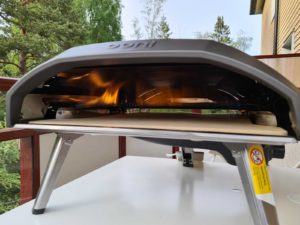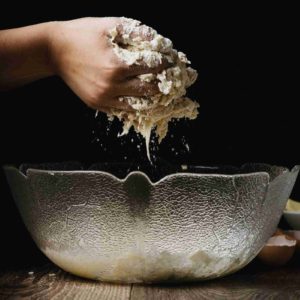You just spent the afternoon preparing for this moment, baking, rising, preparing your good cheese and other delicious toppings, and sitting there in front of the oven in anticipation. It’s time, finally, the pepperoni is perfectly cooked and the cheese is deliciously melted. You take your perfectly crispy pizza out of the oven. But wait… something is wrong, it’s all soggy! The crust isn’t light, crispy, and nicely browned. it’s wet and has to be eaten with a spoon. If this sounds familiar, you’ve come to the right place! One of the main challenges with pizza making at home is making crispy pizza. Luckily it’s easy to fix!
Why your pizza isn’t crispy
If you’ve ever tried to make Italian or New York-style pizza, you’ve probably noticed that it’s really hard to get the pizza as crispy as your favorite pizza place. But why is it so hard to make crispy pizza at home?
The most common reasons your pizza isn’t crispy are:
- The wrong dough
- Too much moisture from sauce, cheese, and toppings
- The wrong temperature and baking method
Traditional Neapolitan pizza is baked in a wood-fired oven at around 900°F (480°C). And New York-style pizza is typically baked in a brick 600-700°F (315-370°C) brick oven.
No matter what type of pizza you make, the key to crispy pizza is a high baking temperature that gets rid of water during baking. To get crispy, enough water needs to evaporate in the oven. Baking time and temperature play an important role, but also the type of dough and toppings you use.
You can compensate for the lack of heat in your oven by baking the pizza longer at a lower temperature. But a too long bake will dry out the crust. So you want to bake the pizza as hot as possible.
You can also make adjustments to the dough to help it bake faster and get crispier.
Loading up the pizza with too much sauce cheese and toppings will also make it take longer to crisp because of added moisture.
Dough for a crispy pizza
Traditional Neapolitan pizza dough consists of only four ingredients: water, flour, salt, and yeast. This dough is designed to not burn in a hot wood-fired oven. But your home ovens can’t reach the same temperature. So, the things that prevent the pizza from burning in the wood-fired oven work against you at home. Luckily there are a few adjustments you can do to improve your dough.
Adding oil to your pizza dough for a faster bake
Oil conducts heat well something that will help the crust bake faster and get crispier.
Neapolitan pizza dough doesn’t contain oil. The reason is that oil helps conduct well. If you bake pizza in a blazing hot oven, you don’t want a very conductive dough because it will not only make your pizza crispy but also burn fast. But when you bake pizza at home, you can take advantage of this to make crispier pizza by adding oil to the dough.
How Much Oil Should You Add?
A good starting point is 3% oil in the dough using baker’s percentages. Baker’s percentages simply mean how much of an ingredient the dough contains compared to flour. If you for example use 1000g of flour in your dough, 3% oil is 30g.
If you add less oil it will be less conductive and if you add more it will get more conductive. However, if you add too much oil to the dough you will alter the consistency of the crust, and it will get more biscuit or pie-like (just like Chicago Deep Dish pizza).
Adding sugar to your pizza dough
Sugar is another ingredient you don’t find in Neapolitan pizza dough. Adding sugar will not make the crust that much crispier, but it will help to brown the pizza crust and get it a bit closer to a Neapolitan-style pizza.
Make the crust thinner
Another common mistake is making too thick a pizza crust. A thick pizza crust takes longer to bake, and that makes it harder to make it crispy.
Select the right sauce, cheese, and toppings
Moisture from the toppings is one of your worst enemies. Too much moisture makes the dough soggy, and hard to make crispy.
Sauce for a crispy pizza
Too much or too much watery sauce will make your pizza soggy.
To avoid making your pizza soggy, you should not add too much sauce. The more sauce you add, the longer it’s going to take to evaporate enough water during baking to crisp the crust.
If you’re boiling your pizza sauce, just let it simmer for a while to boil out excess liquids. How much you should reduce your sauce depends on how liquid it is. You just have to experiment a little bit to get the best result possible.
Cheese for a crispy pizza
If you’re using fresh mozzarella cheese for your pizza, it often comes in a container floating in liquids. I recommend draining the cheese in advance, by absorbing the excess moisture using a kitchen towel or paper towel. It’s also a good idea to cut the cheese and let it dry in the fridge for a few hours before you’re going to bake your pizza.
For other types of cheese, avoid using very fatty cheese, as this will make your pizza very greasy. Using too much cheese is also a bad idea since this will create a cover over your sauce that traps water from evaporating from the sauce during baking.
Toppings for a crispy pizza
You should avoid using toppings that release a lot of water during cooking. Or at least limit how the amount of these toppings.
Examples of watery toppings are tomatoes, broccoli, and other vegetables. You can of course put vegetables on your pizza, but be careful not to use too much. I suggest not using too many toppings in general. Like the cheese, too many toppings will trap water. Also, stay away from very fatty toppings because it makes your pizza greasier. When it comes to pizza toppings, less is more!
Baking crispier pizza
The most important part of crispy pizza is baking. To get the crispiest result, you have to increase the temperature. You need both a higher oven temperature to bake the top of the pizza and a hot baking surface to bake the bottom of the pizza.
Increase your oven temperature to bake your pizza crispier
The first, and most obvious way to make your pizza crispier in the oven is to increase the temperature. The hotter the oven, the quicker your pizza will bake, and the crispier the pizza will be. I recommend just cranking up the temperature to the hottest setting.
The second thing you want to do is use a baking surface to bake the pizza to crisp the bottom faster. A baking surface, such as a pizza stone or steel is going to almost turn your home oven into a
One of the problems when baking pizza at home is that the pizza doesn’t have a hot surface to bake on. If you put your pizza on a baking tray and then put it in the oven, the tray doesn’t have enough time to get hot. Baking pizza on a cold baking tray is not ideal!
How to make pizza crust crispy using a pizza stone
A pizza stone is a great way to simulate a
When you preheat a pizza stone, it retains heat, which later helps bake your pizza faster and hotter. And that will result in a crispier pizza.
Simply preheat your oven for 45 minutes to 1 hour at the highest temperature setting, and bake the pizza directly on the surface.
How to make pizza crust crispy using a pizza steel
An even better option than a pizza stone is a
Like with the stone, you should preheat it in the oven at maximum temperature for at least 45 minutes to 1 hour. Then bake the pizza directly on the hot surface.
A
If you want to know more about pizza steels, check out our article.
How to make crispy pizza without a pizza stone or steel
Even if using a pizza stone or
Baking tray
Your first option is to use a baking tray. You can get a pretty similar result to a pizza stone using a baking tray. Most baking trays nowadays are made out of aluminum, which is a light, soft metal that doesn’t conduct heat very well. Therefore adding multiple trays together will help. If you happen to have a tray made out of iron or steel, it’s even better!
You can use it the same way as a
Cast-iron skillet
Another great option is to bake the pizza in a cast-iron skillet. Iron conducts heat well, like a
Conclusion
To summarize, the key to crispy pizza at home is to use the right type of dough, with oil that helps the dough conduct heat better, and vaporize more water during baking. Another important thing is to make sure the pizza base is thin, so it bakes quickly enough. You should reduce the moisture by using less watery sauce, avoiding wet and greasy cheese, and selecting non-watery toppings. The last thing is to bake the pizza in a really hot oven and use a surface that conducts heat well, like a
Related
- Is Your Pizza Dough Too Dry? Here is How to fix it! - June 10, 2024
- The Ultimate Guide to the Pizza Dough Windowpane Test - June 8, 2024
- The Ultimate Guide to Autolyse Pizza Dough - June 7, 2024




